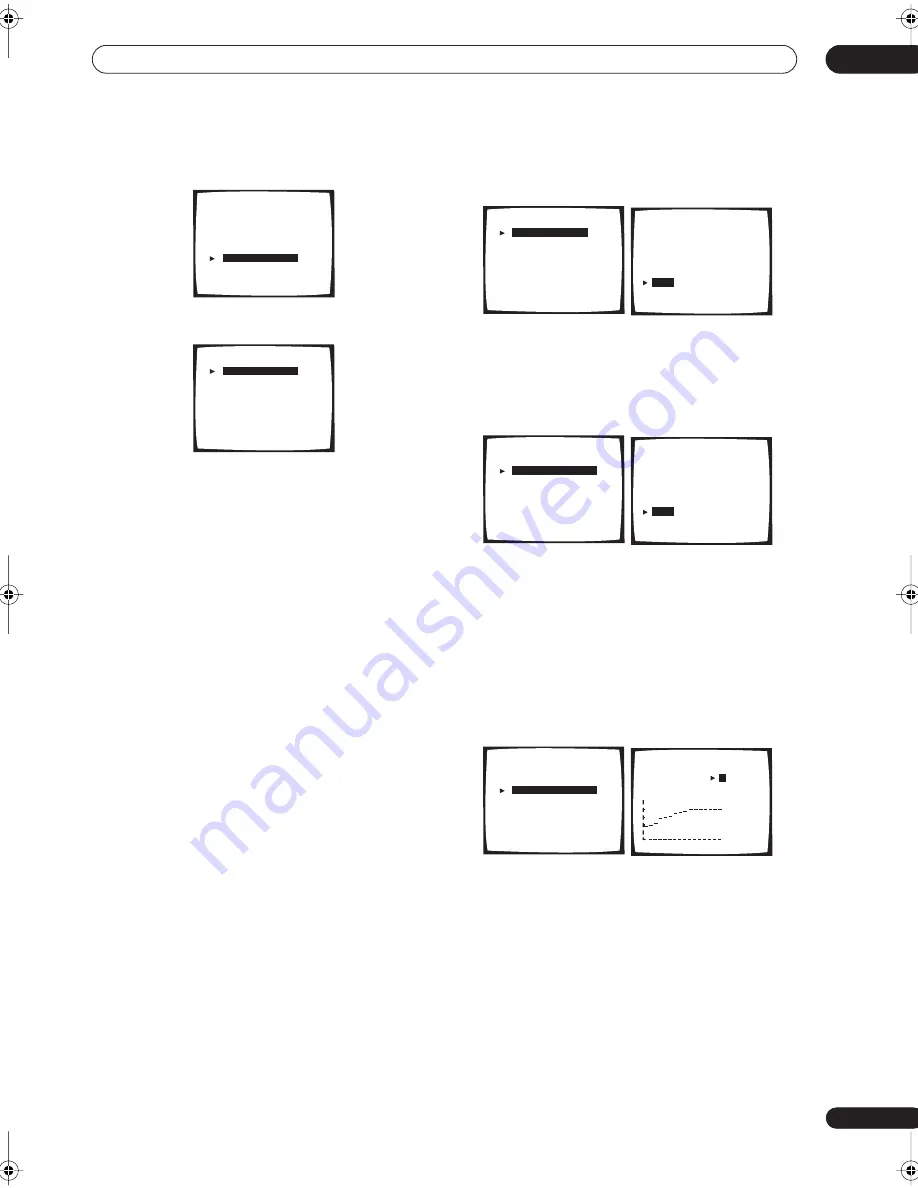
Advanced setup
11
81
En
2
Select ‘Professional’.
3
Select a setup option.
•
Auto Pro.
– This is the recommended setup when
using the Professional Acoustic Calibration. If you
feel confident with a setup that’s more involved, you
can use an advanced setup below. With this setup,
the receiver automatically sets an early time period
(20–40 ms or 60–80 ms) for reverb measurement,
giving you a system calibration based on the direct
sound coming from the speakers. The frequency
balance for each channel is then adjusted to
minimize the effect of the room characteristics on the
overall sound.
•
Reverb Measurement
– Use this to measure the
reverb characteristics of your room for each channel
in select frequency ranges. Since this measurement
is also made in
Auto Pro
(above), there is no need to
do this again if you were satisfied with the results.
•
Reverb View
– You can check the reverb
measurements made for specified frequency ranges
in each channel.
•
PC Output
– See
Connecting a PC for Advanced
MCACC output
on page 70 for more on this option.
•
Advanced EQ Setup
– Use this to select the time
period that will be used for frequency adjustment and
calibration, based on the reverb measurement of
your listening area. Note that this advanced setup is
not necessary if you’re satisfied with the results of
Automatically setting up for surround sound
on
page 12 or
Auto Pro
above (your previous settings
will be altered with this setup).
4
If you selected ‘Auto Pro.’, select ‘Start’ and press
ENTER.
!! Complete !!
is displayed on-screen after the Acoustic
Calibration Equalization is set. Select
Exit
to return to the
Professional Acoustic Calibration menu.
5
If you selected ‘Reverb Measurement’, select
‘Start’ and press ENTER.
!! Complete !!
is displayed on screen when the reverb
measurement is finished (this may take 2–6 minutes).
After selecting
Exit
, you can select
Reverb View
to see
the results on-screen. See
Connecting a PC for Advanced
MCACC output
on page 70 for more on setting up your
computer for the graphical output.
6
If you selected ‘Reverb View’, you can use the
cursor buttons (buttons) to check the reverb
characteristics for each channel. Select ‘Exit’ when
you’re done.
• If
No Data
is displayed, you will need to make a
reverb measurement using the Auto Pro or Reverb
Measurement setup option.
Use the
/
(cursor up/down) buttons (and
ENTER
) to
select the channel and the frequency you want to check.
Note that the markers on the vertical axis indicate
decibels in 2dB steps.
[ EQ AUTO SETTING ]
[
CUSTOM1 ADJUST ]
[ CUSTOM2 ADJUST ]
[
DATA COPY
]
[ DATA CHECK
]
[
Professional
]
[ Exit
]
Acoustic Cal EQ
[
Auto Pro.
]
[
Reverb Measurement ]
[ Reverb View
]
[
PC Output
]
[ Advanced EQ Setup ]
[ Exit
]
Acoustic Cal EQ Pro.
[
Auto Pro.
]
[
Reverb Measurement ]
[ Reverb View
]
[
PC Output
]
[ Advanced EQ Setup ]
[ Exit
]
Acoustic Cal EQ Pro.
Acoustic Cal EQ Pro.
Auto Pro.
•
Set microphone
•
Turn on subwoofer
[
Start
]
[ Cancel ]
[ AUTO Pro.
]
[
Reverb Measurement
]
[ Reverb View
]
[
PC Output
]
[ Advanced EQ Setup ]
[ Exit
]
Acoustic Cal EQ Pro.
Acoustic Cal EQ Pro.
Reverb
•
Set microphone
•
Turn on subwoofer
[
Start
]
[ Cancel ]
[ AUTO Pro.
]
[
Reverb Measurement ]
[
Reverb View
]
[
PC Output
]
[ Advanced EQ Setup ]
[ Exit
]
Acoustic Cal EQ Pro.
Acoustic Cal EQ Pro.
Reverb Vew
[
L
]
[ 63Hz
]
dB
[ Exit
]
0 80
160ms
VSX-54TX_0430.book 81 ページ 2004年5月6日 木曜日 午後8時7分















































